Auditing and Assurance Services Report - T119, University Name
VerifiedAdded on 2023/03/31
|6
|1897
|183
Report
AI Summary
This report analyzes several key areas within auditing and assurance services, focusing on compliance with Australian Accounting Standards. It examines the correct valuation of inventory, highlighting the importance of using the lower of cost or net realizable value, and the auditor's role in obtaining sufficient evidence. The report then addresses the valuation of property, plant, and equipment, emphasizing the requirement to recognize assets at cost and the implications of non-compliance. It further explores inventory valuation methods, specifically the use of FIFO and the issues arising from the use of LIFO. Finally, the report discusses related party disclosures, detailing the importance of disclosing relationships and transactions to ensure transparency and provide a fair view of the financial statements. The report provides practical examples of how auditors should address non-compliance with accounting standards and the appropriate actions to take, including the potential for qualified or adverse opinions.
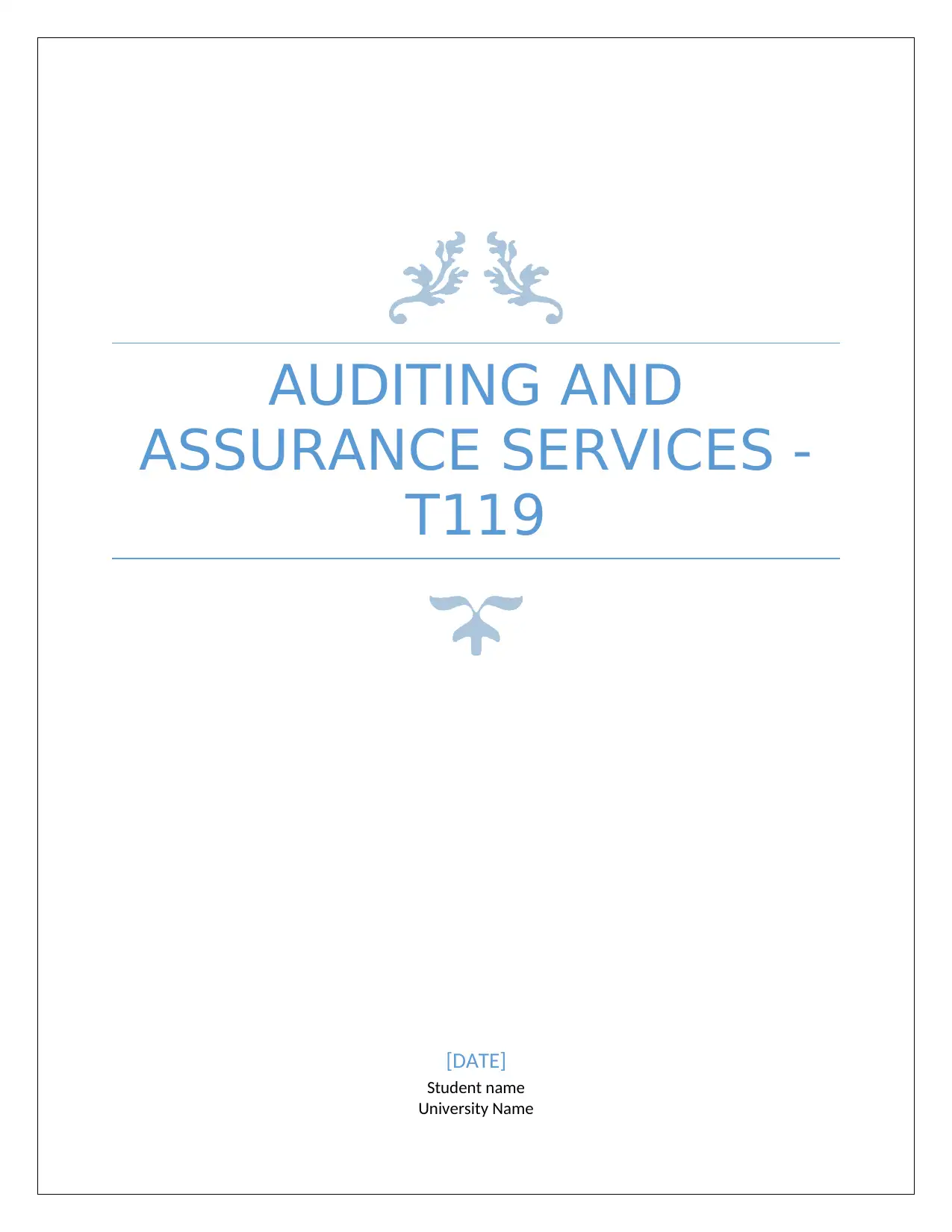
AUDITING AND
ASSURANCE SERVICES -
T119
[DATE]
Student name
University Name
ASSURANCE SERVICES -
T119
[DATE]
Student name
University Name
Paraphrase This Document
Need a fresh take? Get an instant paraphrase of this document with our AI Paraphraser
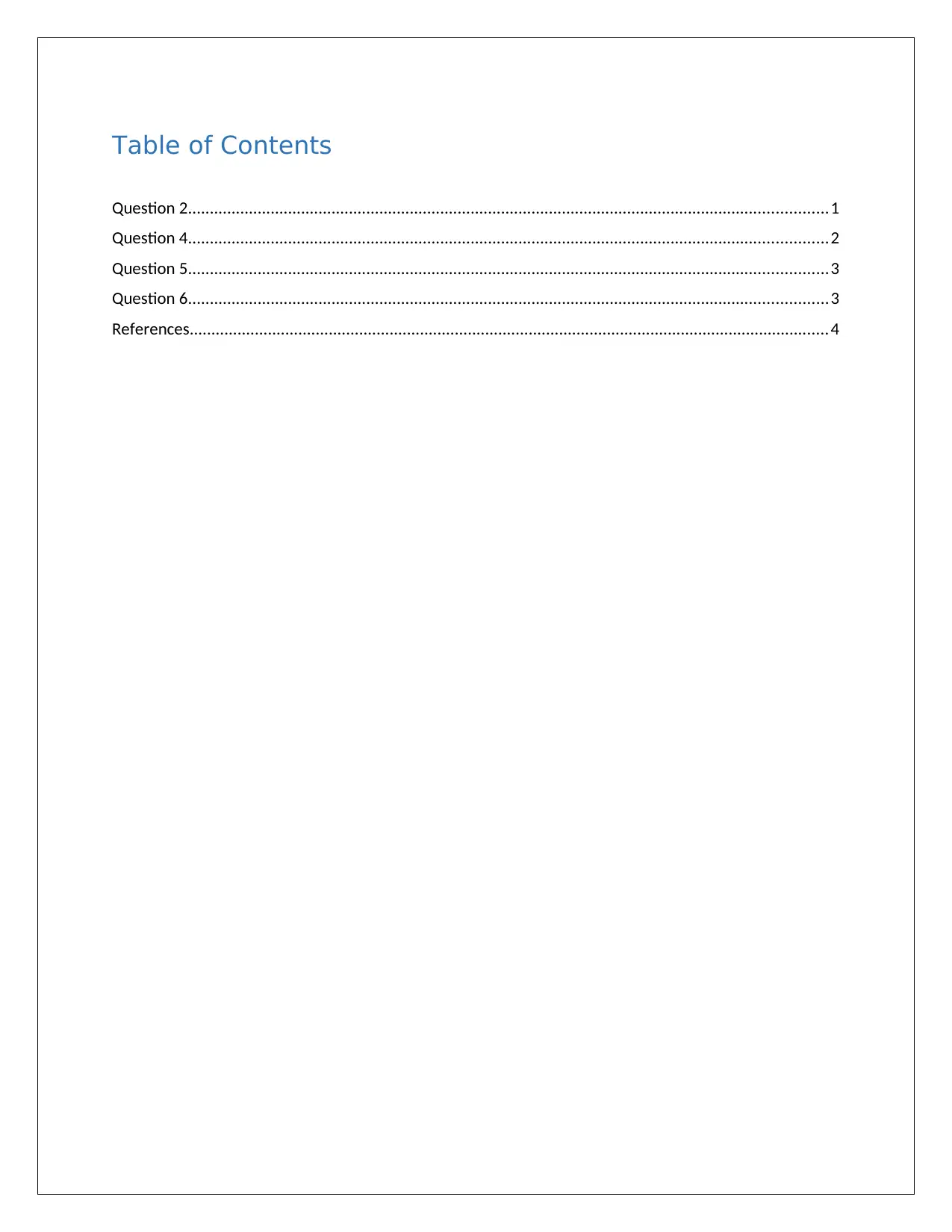
Table of Contents
Question 2...................................................................................................................................................1
Question 4...................................................................................................................................................2
Question 5...................................................................................................................................................3
Question 6...................................................................................................................................................3
References...................................................................................................................................................4
Question 2...................................................................................................................................................1
Question 4...................................................................................................................................................2
Question 5...................................................................................................................................................3
Question 6...................................................................................................................................................3
References...................................................................................................................................................4
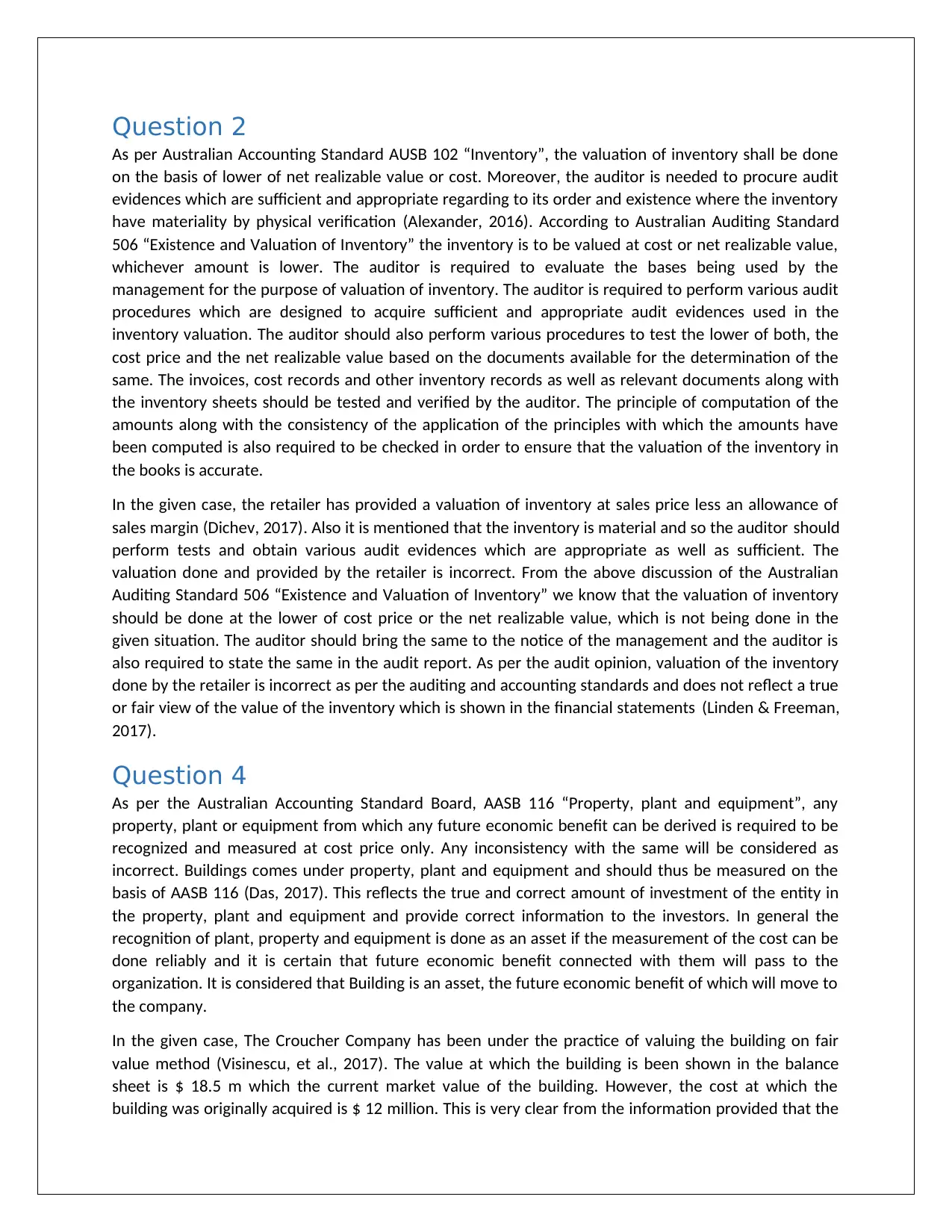
Question 2
As per Australian Accounting Standard AUSB 102 “Inventory”, the valuation of inventory shall be done
on the basis of lower of net realizable value or cost. Moreover, the auditor is needed to procure audit
evidences which are sufficient and appropriate regarding to its order and existence where the inventory
have materiality by physical verification (Alexander, 2016). According to Australian Auditing Standard
506 “Existence and Valuation of Inventory” the inventory is to be valued at cost or net realizable value,
whichever amount is lower. The auditor is required to evaluate the bases being used by the
management for the purpose of valuation of inventory. The auditor is required to perform various audit
procedures which are designed to acquire sufficient and appropriate audit evidences used in the
inventory valuation. The auditor should also perform various procedures to test the lower of both, the
cost price and the net realizable value based on the documents available for the determination of the
same. The invoices, cost records and other inventory records as well as relevant documents along with
the inventory sheets should be tested and verified by the auditor. The principle of computation of the
amounts along with the consistency of the application of the principles with which the amounts have
been computed is also required to be checked in order to ensure that the valuation of the inventory in
the books is accurate.
In the given case, the retailer has provided a valuation of inventory at sales price less an allowance of
sales margin (Dichev, 2017). Also it is mentioned that the inventory is material and so the auditor should
perform tests and obtain various audit evidences which are appropriate as well as sufficient. The
valuation done and provided by the retailer is incorrect. From the above discussion of the Australian
Auditing Standard 506 “Existence and Valuation of Inventory” we know that the valuation of inventory
should be done at the lower of cost price or the net realizable value, which is not being done in the
given situation. The auditor should bring the same to the notice of the management and the auditor is
also required to state the same in the audit report. As per the audit opinion, valuation of the inventory
done by the retailer is incorrect as per the auditing and accounting standards and does not reflect a true
or fair view of the value of the inventory which is shown in the financial statements (Linden & Freeman,
2017).
Question 4
As per the Australian Accounting Standard Board, AASB 116 “Property, plant and equipment”, any
property, plant or equipment from which any future economic benefit can be derived is required to be
recognized and measured at cost price only. Any inconsistency with the same will be considered as
incorrect. Buildings comes under property, plant and equipment and should thus be measured on the
basis of AASB 116 (Das, 2017). This reflects the true and correct amount of investment of the entity in
the property, plant and equipment and provide correct information to the investors. In general the
recognition of plant, property and equipment is done as an asset if the measurement of the cost can be
done reliably and it is certain that future economic benefit connected with them will pass to the
organization. It is considered that Building is an asset, the future economic benefit of which will move to
the company.
In the given case, The Croucher Company has been under the practice of valuing the building on fair
value method (Visinescu, et al., 2017). The value at which the building is been shown in the balance
sheet is $ 18.5 m which the current market value of the building. However, the cost at which the
building was originally acquired is $ 12 million. This is very clear from the information provided that the
As per Australian Accounting Standard AUSB 102 “Inventory”, the valuation of inventory shall be done
on the basis of lower of net realizable value or cost. Moreover, the auditor is needed to procure audit
evidences which are sufficient and appropriate regarding to its order and existence where the inventory
have materiality by physical verification (Alexander, 2016). According to Australian Auditing Standard
506 “Existence and Valuation of Inventory” the inventory is to be valued at cost or net realizable value,
whichever amount is lower. The auditor is required to evaluate the bases being used by the
management for the purpose of valuation of inventory. The auditor is required to perform various audit
procedures which are designed to acquire sufficient and appropriate audit evidences used in the
inventory valuation. The auditor should also perform various procedures to test the lower of both, the
cost price and the net realizable value based on the documents available for the determination of the
same. The invoices, cost records and other inventory records as well as relevant documents along with
the inventory sheets should be tested and verified by the auditor. The principle of computation of the
amounts along with the consistency of the application of the principles with which the amounts have
been computed is also required to be checked in order to ensure that the valuation of the inventory in
the books is accurate.
In the given case, the retailer has provided a valuation of inventory at sales price less an allowance of
sales margin (Dichev, 2017). Also it is mentioned that the inventory is material and so the auditor should
perform tests and obtain various audit evidences which are appropriate as well as sufficient. The
valuation done and provided by the retailer is incorrect. From the above discussion of the Australian
Auditing Standard 506 “Existence and Valuation of Inventory” we know that the valuation of inventory
should be done at the lower of cost price or the net realizable value, which is not being done in the
given situation. The auditor should bring the same to the notice of the management and the auditor is
also required to state the same in the audit report. As per the audit opinion, valuation of the inventory
done by the retailer is incorrect as per the auditing and accounting standards and does not reflect a true
or fair view of the value of the inventory which is shown in the financial statements (Linden & Freeman,
2017).
Question 4
As per the Australian Accounting Standard Board, AASB 116 “Property, plant and equipment”, any
property, plant or equipment from which any future economic benefit can be derived is required to be
recognized and measured at cost price only. Any inconsistency with the same will be considered as
incorrect. Buildings comes under property, plant and equipment and should thus be measured on the
basis of AASB 116 (Das, 2017). This reflects the true and correct amount of investment of the entity in
the property, plant and equipment and provide correct information to the investors. In general the
recognition of plant, property and equipment is done as an asset if the measurement of the cost can be
done reliably and it is certain that future economic benefit connected with them will pass to the
organization. It is considered that Building is an asset, the future economic benefit of which will move to
the company.
In the given case, The Croucher Company has been under the practice of valuing the building on fair
value method (Visinescu, et al., 2017). The value at which the building is been shown in the balance
sheet is $ 18.5 m which the current market value of the building. However, the cost at which the
building was originally acquired is $ 12 million. This is very clear from the information provided that the
⊘ This is a preview!⊘
Do you want full access?
Subscribe today to unlock all pages.

Trusted by 1+ million students worldwide
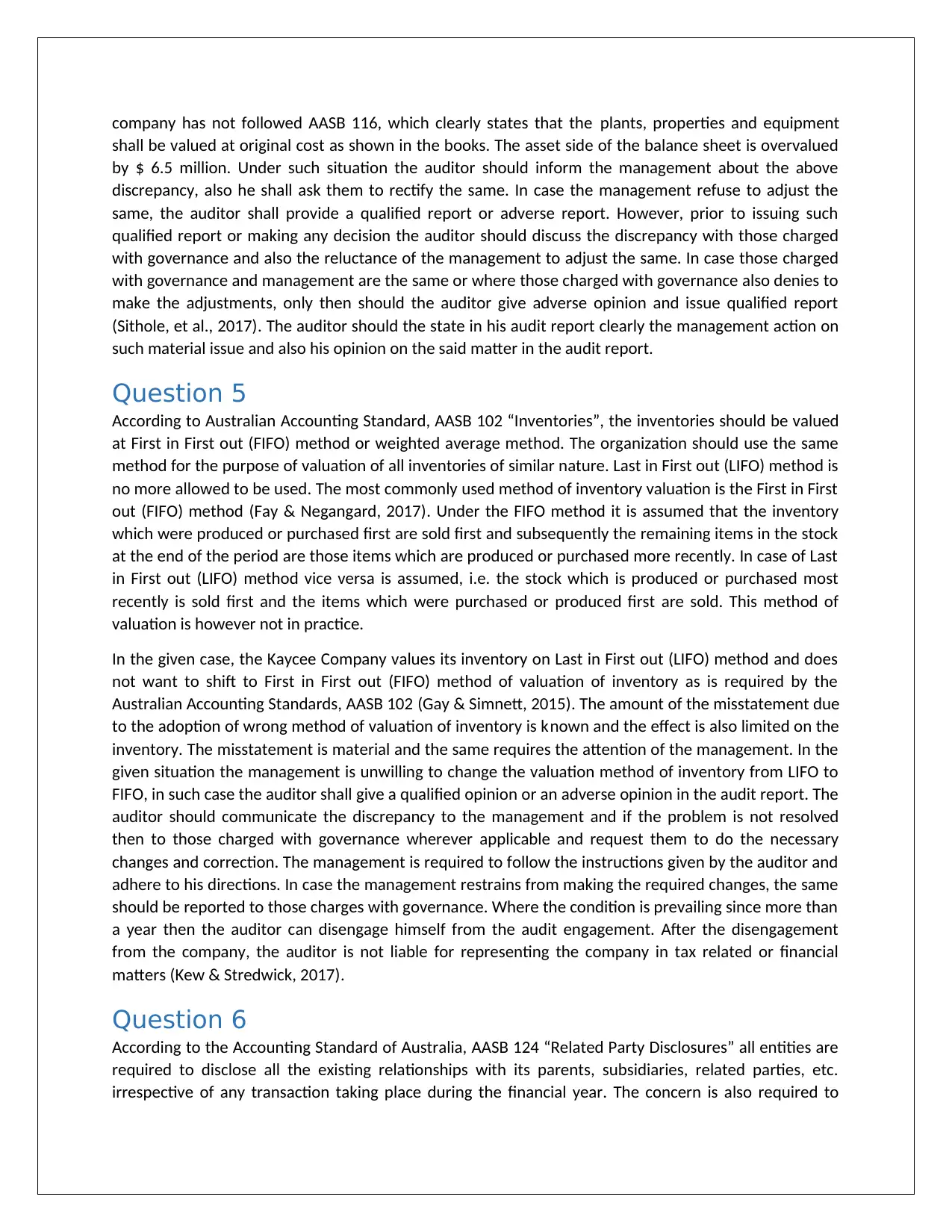
company has not followed AASB 116, which clearly states that the plants, properties and equipment
shall be valued at original cost as shown in the books. The asset side of the balance sheet is overvalued
by $ 6.5 million. Under such situation the auditor should inform the management about the above
discrepancy, also he shall ask them to rectify the same. In case the management refuse to adjust the
same, the auditor shall provide a qualified report or adverse report. However, prior to issuing such
qualified report or making any decision the auditor should discuss the discrepancy with those charged
with governance and also the reluctance of the management to adjust the same. In case those charged
with governance and management are the same or where those charged with governance also denies to
make the adjustments, only then should the auditor give adverse opinion and issue qualified report
(Sithole, et al., 2017). The auditor should the state in his audit report clearly the management action on
such material issue and also his opinion on the said matter in the audit report.
Question 5
According to Australian Accounting Standard, AASB 102 “Inventories”, the inventories should be valued
at First in First out (FIFO) method or weighted average method. The organization should use the same
method for the purpose of valuation of all inventories of similar nature. Last in First out (LIFO) method is
no more allowed to be used. The most commonly used method of inventory valuation is the First in First
out (FIFO) method (Fay & Negangard, 2017). Under the FIFO method it is assumed that the inventory
which were produced or purchased first are sold first and subsequently the remaining items in the stock
at the end of the period are those items which are produced or purchased more recently. In case of Last
in First out (LIFO) method vice versa is assumed, i.e. the stock which is produced or purchased most
recently is sold first and the items which were purchased or produced first are sold. This method of
valuation is however not in practice.
In the given case, the Kaycee Company values its inventory on Last in First out (LIFO) method and does
not want to shift to First in First out (FIFO) method of valuation of inventory as is required by the
Australian Accounting Standards, AASB 102 (Gay & Simnett, 2015). The amount of the misstatement due
to the adoption of wrong method of valuation of inventory is known and the effect is also limited on the
inventory. The misstatement is material and the same requires the attention of the management. In the
given situation the management is unwilling to change the valuation method of inventory from LIFO to
FIFO, in such case the auditor shall give a qualified opinion or an adverse opinion in the audit report. The
auditor should communicate the discrepancy to the management and if the problem is not resolved
then to those charged with governance wherever applicable and request them to do the necessary
changes and correction. The management is required to follow the instructions given by the auditor and
adhere to his directions. In case the management restrains from making the required changes, the same
should be reported to those charges with governance. Where the condition is prevailing since more than
a year then the auditor can disengage himself from the audit engagement. After the disengagement
from the company, the auditor is not liable for representing the company in tax related or financial
matters (Kew & Stredwick, 2017).
Question 6
According to the Accounting Standard of Australia, AASB 124 “Related Party Disclosures” all entities are
required to disclose all the existing relationships with its parents, subsidiaries, related parties, etc.
irrespective of any transaction taking place during the financial year. The concern is also required to
shall be valued at original cost as shown in the books. The asset side of the balance sheet is overvalued
by $ 6.5 million. Under such situation the auditor should inform the management about the above
discrepancy, also he shall ask them to rectify the same. In case the management refuse to adjust the
same, the auditor shall provide a qualified report or adverse report. However, prior to issuing such
qualified report or making any decision the auditor should discuss the discrepancy with those charged
with governance and also the reluctance of the management to adjust the same. In case those charged
with governance and management are the same or where those charged with governance also denies to
make the adjustments, only then should the auditor give adverse opinion and issue qualified report
(Sithole, et al., 2017). The auditor should the state in his audit report clearly the management action on
such material issue and also his opinion on the said matter in the audit report.
Question 5
According to Australian Accounting Standard, AASB 102 “Inventories”, the inventories should be valued
at First in First out (FIFO) method or weighted average method. The organization should use the same
method for the purpose of valuation of all inventories of similar nature. Last in First out (LIFO) method is
no more allowed to be used. The most commonly used method of inventory valuation is the First in First
out (FIFO) method (Fay & Negangard, 2017). Under the FIFO method it is assumed that the inventory
which were produced or purchased first are sold first and subsequently the remaining items in the stock
at the end of the period are those items which are produced or purchased more recently. In case of Last
in First out (LIFO) method vice versa is assumed, i.e. the stock which is produced or purchased most
recently is sold first and the items which were purchased or produced first are sold. This method of
valuation is however not in practice.
In the given case, the Kaycee Company values its inventory on Last in First out (LIFO) method and does
not want to shift to First in First out (FIFO) method of valuation of inventory as is required by the
Australian Accounting Standards, AASB 102 (Gay & Simnett, 2015). The amount of the misstatement due
to the adoption of wrong method of valuation of inventory is known and the effect is also limited on the
inventory. The misstatement is material and the same requires the attention of the management. In the
given situation the management is unwilling to change the valuation method of inventory from LIFO to
FIFO, in such case the auditor shall give a qualified opinion or an adverse opinion in the audit report. The
auditor should communicate the discrepancy to the management and if the problem is not resolved
then to those charged with governance wherever applicable and request them to do the necessary
changes and correction. The management is required to follow the instructions given by the auditor and
adhere to his directions. In case the management restrains from making the required changes, the same
should be reported to those charges with governance. Where the condition is prevailing since more than
a year then the auditor can disengage himself from the audit engagement. After the disengagement
from the company, the auditor is not liable for representing the company in tax related or financial
matters (Kew & Stredwick, 2017).
Question 6
According to the Accounting Standard of Australia, AASB 124 “Related Party Disclosures” all entities are
required to disclose all the existing relationships with its parents, subsidiaries, related parties, etc.
irrespective of any transaction taking place during the financial year. The concern is also required to
Paraphrase This Document
Need a fresh take? Get an instant paraphrase of this document with our AI Paraphraser
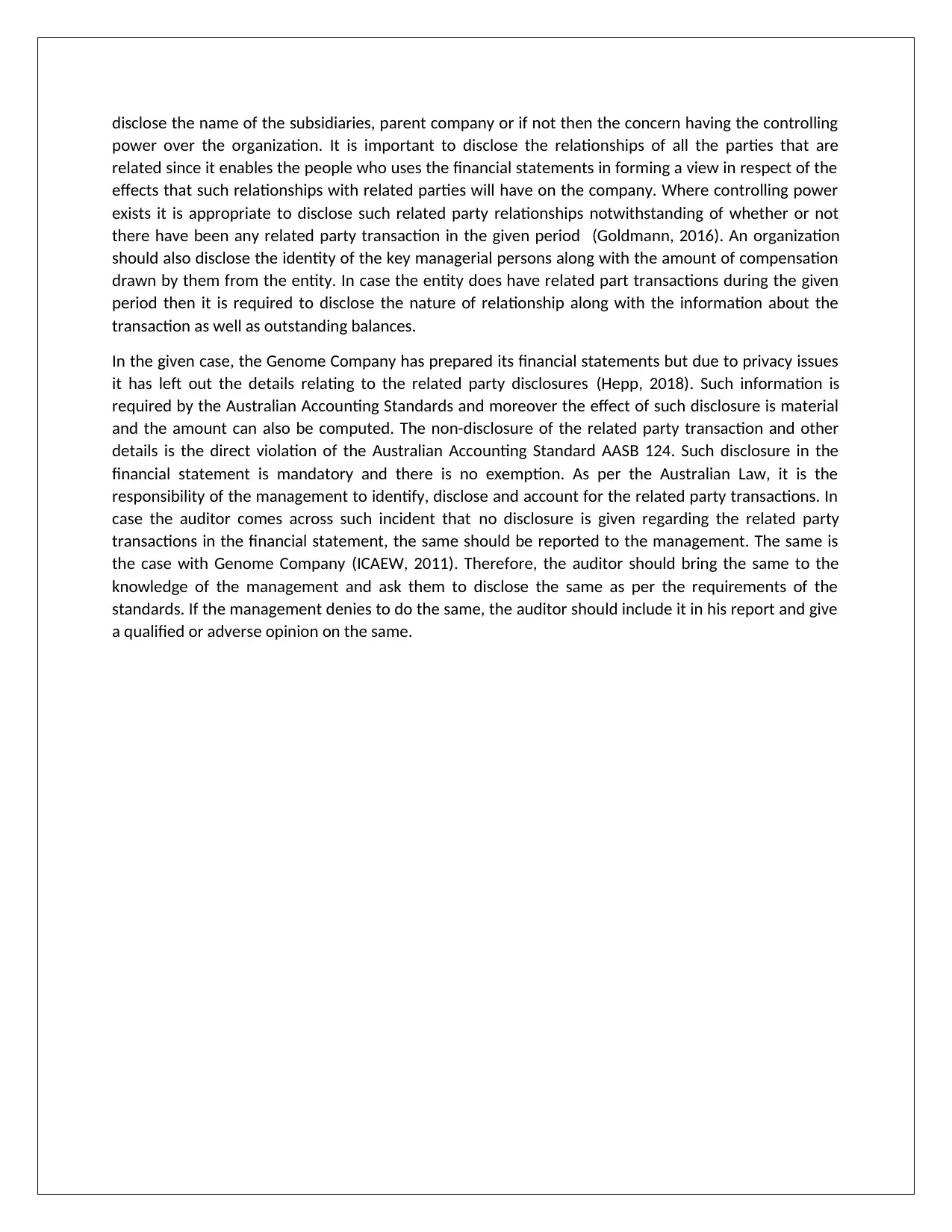
disclose the name of the subsidiaries, parent company or if not then the concern having the controlling
power over the organization. It is important to disclose the relationships of all the parties that are
related since it enables the people who uses the financial statements in forming a view in respect of the
effects that such relationships with related parties will have on the company. Where controlling power
exists it is appropriate to disclose such related party relationships notwithstanding of whether or not
there have been any related party transaction in the given period (Goldmann, 2016). An organization
should also disclose the identity of the key managerial persons along with the amount of compensation
drawn by them from the entity. In case the entity does have related part transactions during the given
period then it is required to disclose the nature of relationship along with the information about the
transaction as well as outstanding balances.
In the given case, the Genome Company has prepared its financial statements but due to privacy issues
it has left out the details relating to the related party disclosures (Hepp, 2018). Such information is
required by the Australian Accounting Standards and moreover the effect of such disclosure is material
and the amount can also be computed. The non-disclosure of the related party transaction and other
details is the direct violation of the Australian Accounting Standard AASB 124. Such disclosure in the
financial statement is mandatory and there is no exemption. As per the Australian Law, it is the
responsibility of the management to identify, disclose and account for the related party transactions. In
case the auditor comes across such incident that no disclosure is given regarding the related party
transactions in the financial statement, the same should be reported to the management. The same is
the case with Genome Company (ICAEW, 2011). Therefore, the auditor should bring the same to the
knowledge of the management and ask them to disclose the same as per the requirements of the
standards. If the management denies to do the same, the auditor should include it in his report and give
a qualified or adverse opinion on the same.
power over the organization. It is important to disclose the relationships of all the parties that are
related since it enables the people who uses the financial statements in forming a view in respect of the
effects that such relationships with related parties will have on the company. Where controlling power
exists it is appropriate to disclose such related party relationships notwithstanding of whether or not
there have been any related party transaction in the given period (Goldmann, 2016). An organization
should also disclose the identity of the key managerial persons along with the amount of compensation
drawn by them from the entity. In case the entity does have related part transactions during the given
period then it is required to disclose the nature of relationship along with the information about the
transaction as well as outstanding balances.
In the given case, the Genome Company has prepared its financial statements but due to privacy issues
it has left out the details relating to the related party disclosures (Hepp, 2018). Such information is
required by the Australian Accounting Standards and moreover the effect of such disclosure is material
and the amount can also be computed. The non-disclosure of the related party transaction and other
details is the direct violation of the Australian Accounting Standard AASB 124. Such disclosure in the
financial statement is mandatory and there is no exemption. As per the Australian Law, it is the
responsibility of the management to identify, disclose and account for the related party transactions. In
case the auditor comes across such incident that no disclosure is given regarding the related party
transactions in the financial statement, the same should be reported to the management. The same is
the case with Genome Company (ICAEW, 2011). Therefore, the auditor should bring the same to the
knowledge of the management and ask them to disclose the same as per the requirements of the
standards. If the management denies to do the same, the auditor should include it in his report and give
a qualified or adverse opinion on the same.
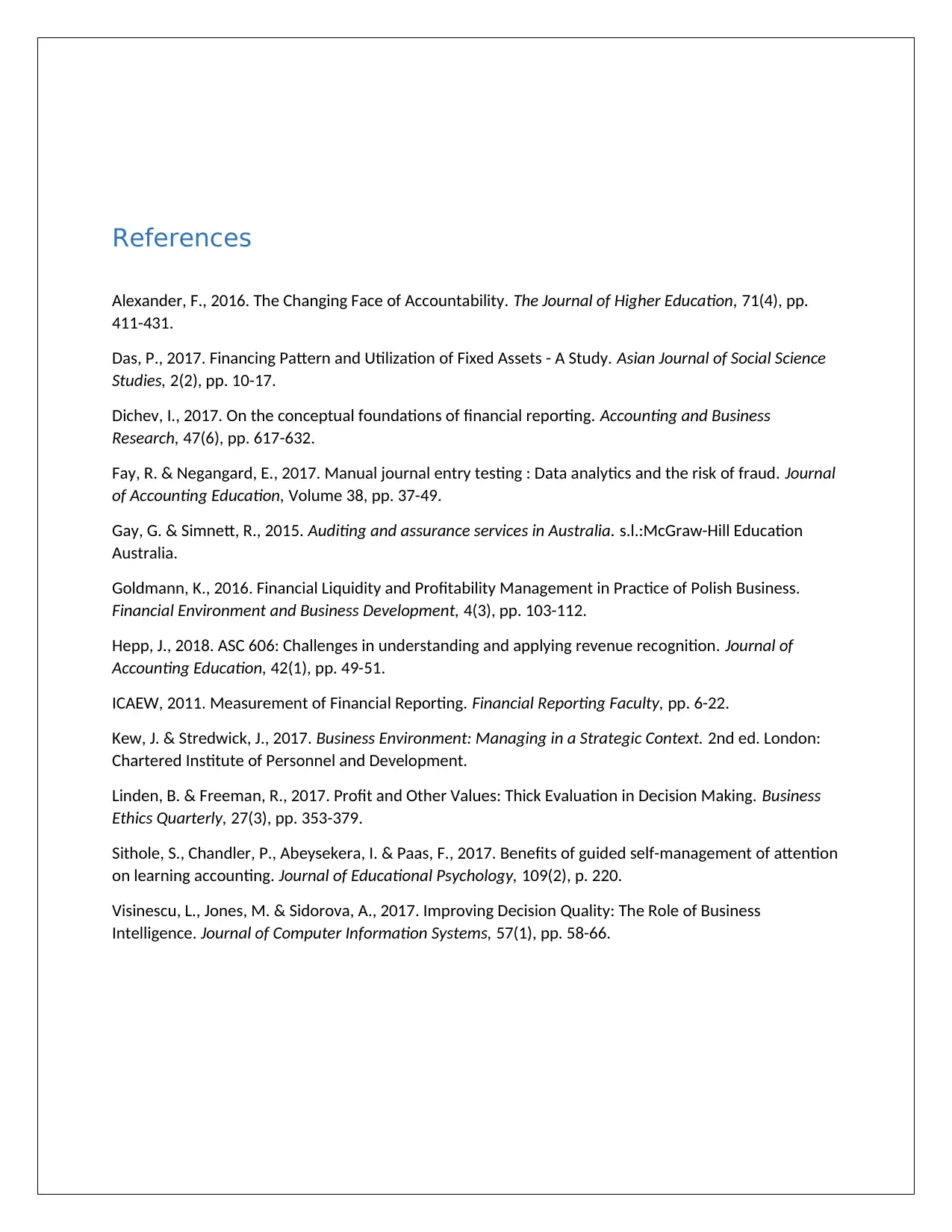
References
Alexander, F., 2016. The Changing Face of Accountability. The Journal of Higher Education, 71(4), pp.
411-431.
Das, P., 2017. Financing Pattern and Utilization of Fixed Assets - A Study. Asian Journal of Social Science
Studies, 2(2), pp. 10-17.
Dichev, I., 2017. On the conceptual foundations of financial reporting. Accounting and Business
Research, 47(6), pp. 617-632.
Fay, R. & Negangard, E., 2017. Manual journal entry testing : Data analytics and the risk of fraud. Journal
of Accounting Education, Volume 38, pp. 37-49.
Gay, G. & Simnett, R., 2015. Auditing and assurance services in Australia. s.l.:McGraw-Hill Education
Australia.
Goldmann, K., 2016. Financial Liquidity and Profitability Management in Practice of Polish Business.
Financial Environment and Business Development, 4(3), pp. 103-112.
Hepp, J., 2018. ASC 606: Challenges in understanding and applying revenue recognition. Journal of
Accounting Education, 42(1), pp. 49-51.
ICAEW, 2011. Measurement of Financial Reporting. Financial Reporting Faculty, pp. 6-22.
Kew, J. & Stredwick, J., 2017. Business Environment: Managing in a Strategic Context. 2nd ed. London:
Chartered Institute of Personnel and Development.
Linden, B. & Freeman, R., 2017. Profit and Other Values: Thick Evaluation in Decision Making. Business
Ethics Quarterly, 27(3), pp. 353-379.
Sithole, S., Chandler, P., Abeysekera, I. & Paas, F., 2017. Benefits of guided self-management of attention
on learning accounting. Journal of Educational Psychology, 109(2), p. 220.
Visinescu, L., Jones, M. & Sidorova, A., 2017. Improving Decision Quality: The Role of Business
Intelligence. Journal of Computer Information Systems, 57(1), pp. 58-66.
Alexander, F., 2016. The Changing Face of Accountability. The Journal of Higher Education, 71(4), pp.
411-431.
Das, P., 2017. Financing Pattern and Utilization of Fixed Assets - A Study. Asian Journal of Social Science
Studies, 2(2), pp. 10-17.
Dichev, I., 2017. On the conceptual foundations of financial reporting. Accounting and Business
Research, 47(6), pp. 617-632.
Fay, R. & Negangard, E., 2017. Manual journal entry testing : Data analytics and the risk of fraud. Journal
of Accounting Education, Volume 38, pp. 37-49.
Gay, G. & Simnett, R., 2015. Auditing and assurance services in Australia. s.l.:McGraw-Hill Education
Australia.
Goldmann, K., 2016. Financial Liquidity and Profitability Management in Practice of Polish Business.
Financial Environment and Business Development, 4(3), pp. 103-112.
Hepp, J., 2018. ASC 606: Challenges in understanding and applying revenue recognition. Journal of
Accounting Education, 42(1), pp. 49-51.
ICAEW, 2011. Measurement of Financial Reporting. Financial Reporting Faculty, pp. 6-22.
Kew, J. & Stredwick, J., 2017. Business Environment: Managing in a Strategic Context. 2nd ed. London:
Chartered Institute of Personnel and Development.
Linden, B. & Freeman, R., 2017. Profit and Other Values: Thick Evaluation in Decision Making. Business
Ethics Quarterly, 27(3), pp. 353-379.
Sithole, S., Chandler, P., Abeysekera, I. & Paas, F., 2017. Benefits of guided self-management of attention
on learning accounting. Journal of Educational Psychology, 109(2), p. 220.
Visinescu, L., Jones, M. & Sidorova, A., 2017. Improving Decision Quality: The Role of Business
Intelligence. Journal of Computer Information Systems, 57(1), pp. 58-66.
⊘ This is a preview!⊘
Do you want full access?
Subscribe today to unlock all pages.

Trusted by 1+ million students worldwide
1 out of 6
Related Documents
Your All-in-One AI-Powered Toolkit for Academic Success.
+13062052269
info@desklib.com
Available 24*7 on WhatsApp / Email
![[object Object]](/_next/static/media/star-bottom.7253800d.svg)
Unlock your academic potential
Copyright © 2020–2025 A2Z Services. All Rights Reserved. Developed and managed by ZUCOL.





